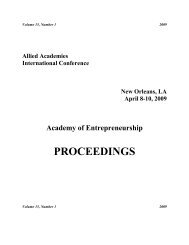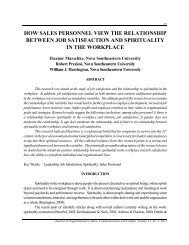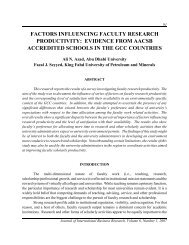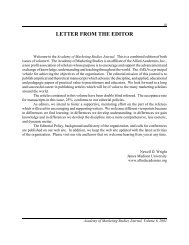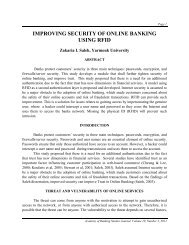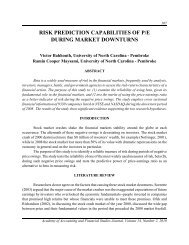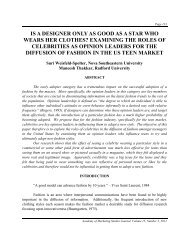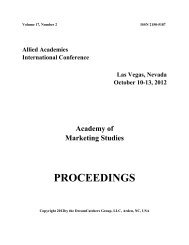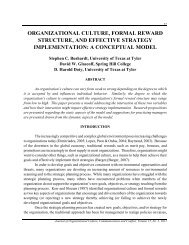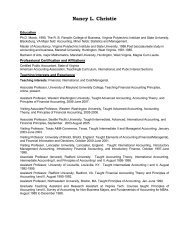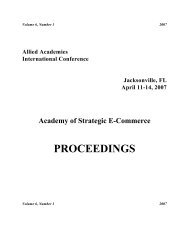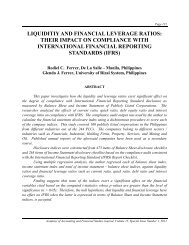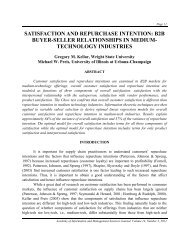E:\Jim's Files\AA Journals\JOCCC\JOCCC Vol ... - Allied Academies
E:\Jim's Files\AA Journals\JOCCC\JOCCC Vol ... - Allied Academies
E:\Jim's Files\AA Journals\JOCCC\JOCCC Vol ... - Allied Academies
You also want an ePaper? Increase the reach of your titles
YUMPU automatically turns print PDFs into web optimized ePapers that Google loves.
35<br />
CORPORATE REPUTATION MANAGEMENT:<br />
CITIBANK’S USE OF IMAGE RESTORATION<br />
STRATEGIES DURING THE U.S. BANKING CRISIS<br />
Marsha Weber, Minnesota State University Moorhead<br />
Sheri L. Erickson, Minnesota State University Moorhead<br />
Mary Stone, Minnesota State University Moorhead<br />
ABSTRACT<br />
Image management is essential to corporations, particularly during crisis situations. The<br />
ongoing financial crisis in the United States has led to the failure of several banking firms.<br />
Because systemic economic problems may result from the loss of confidence in the banking system,<br />
effective use of crisis management and image restoration strategies by the banking industry is<br />
particularly important. This paper discusses the importance of corporate reputation management,<br />
illustrates the use of communication theory to analyze corporate responses to crisis, and analyzes<br />
Citibank’s responses to the company’s recent financial crisis using two crisis response frameworks,<br />
Coombs’ Situational Crisis Communication Theory (2007) and Benoit’s Image Restoration<br />
Typology (1995). Findings indicate that in general, Citigroup responded to negative events in an<br />
effective manner (Coombs, 2007; Benoit, 1995) and in such a way to reduce the damaging effects<br />
of the crisis. In many instances, Citi used corrective action strategies, in which management<br />
indicated ways to solve problems and to prevent the crisis from happening again.<br />
INTRODUCTION<br />
Image management is essential to corporations and other organizations, particularly in crisis<br />
situations. The financial crisis in the United States, which led to the failure of a large number of<br />
banking firms, has made firm reputation management extremely important. More stakeholders<br />
exist in bank governance than in non-financial types of businesses due to banks’ role in promoting<br />
the stability of the economy and the liquidity function. Therefore, loss of confidence in the banking<br />
system can cause serious, systemic economic problems. The bailout for the financial industry and<br />
the financial rescue packages offered to select large U.S. banking firms as part of the Troubled<br />
Asset Relief Program (TARP) and the TARP Capital Purchase Program served to appease some<br />
concerns of bank customers and stockholders. However, the economic crisis and its aftermath<br />
continue to cause much concern for all stakeholders of banking firms.<br />
The first purpose of this paper is to discuss the importance of corporate reputation<br />
management when crisis situations threaten the company’s image. The second purpose is to<br />
Journal of Organizational Culture, Communications and Conflict, <strong>Vol</strong>ume 15, No. 2, 2011
The body of this manuscript is not reproduced in this posting. The full text of the manuscript is<br />
available through most university libraries. Should you have difficulty in finding the full text,<br />
you may acquire it from the original journal. Visit http://www.alliedacademies.org to find a link<br />
to the original journal source.
organizations used similar strategies and whether the firms were successful in their image<br />
restoration attempts. In addition, a study of the various sectors of the banking industry could<br />
provide information concerning the communication strategies those organizations used to repair<br />
a tarnished image. For example, all image restoration strategies that bank regulators used to answer<br />
media questions could be analyzed to determine if the same patterns emerged. Also, other types<br />
of organizations and industries could be studied to determine if the communication patterns are<br />
different than those of the banking industry.<br />
A study of bank industry and government (regulator) reputations and their responses to<br />
their roles in the banking crisis, could provide an interesting complement to studies of individual<br />
firms. Winn, et al. (2008, pp. 36-37) define industry reputation as “the collective judgments of an<br />
industry by stakeholders and the general public, where the judgment is based on assessments of the<br />
economic, social and environmental impacts attributed to that industry over time.” An industry can<br />
undergo collective reputation management, which refers to “all activities and behavior undertaken<br />
by members of the collective to deliberately alter judgments about the reputation of the collective”<br />
(Winn, et al., 2008, p. 37). Regulators (the government) play a role in industry reputation<br />
management by attempting to allay stockholder concerns about the viability of the banking industry<br />
and the financial system (Winn, et al., 2008).<br />
53<br />
REFERENCES<br />
Adolphus, M. (n.d.). How to use discourse analysis. Retrieved February 17, 2010 from<br />
http://info.emeraldinsight.com/research/guides/discourse_analysis.htmview=print.<br />
Balmer, J.M.T. & Gray, E.R. (2003). Corporate brands: What are they What of them European Journal of Marketing,<br />
37 (7/8), 972-997.<br />
Benoit, W.L. (1995). Accounts, excuses, and apologies: A theory of image restoration. Albany, NY: State University<br />
of New York Press.<br />
Benoit, W. L. (1997). Image repair discourse and crisis communication. Public Relations Review. 23 (2), 177-186.<br />
Benoit, W. (2006). President Bush’s image repair effort on Meet the Press: The complexities of defeasibility. Journal<br />
of Applied Communication Research, 34 (3), 285-306.<br />
Benoit, W.L. & Brinson, S. (1994). AT&T: Apologies are not enough. Communication Quarterly, 42, 75-88.<br />
Benoit, W.L. & Czerwinski, A. (1997). A critical analysis of USAir’s image repair discourse. Business Communication<br />
Quarterly, 60 (3), 38-57.<br />
Benoit, W. & Henson, J. (2009). President Bush’s image repair discourse on Hurricane Katrina. Public Relations<br />
Review, 35, 40-46.<br />
Journal of Organizational Culture, Communications and Conflict, <strong>Vol</strong>ume 15, No. 2, 2011
54<br />
Blaney, J., Benoit, W.L., & Brazeal, L. (2002). Blowout!: Firestone’s image restoration campaign. Public Relations<br />
Review, 28, 379-392.<br />
Brinson, S. & Benoit, W.L. (1999). The tarnished star: Restoring Texaco’s damaged public image. Management<br />
Communication Quarterly, 4, 483-510.<br />
Caldiero, C. (2005). A wardrobe malfunction: The 2004 Super Bowl halftime incident in the context of image<br />
restoration strategies and the cocreational perspective. Unpublished paper presented at the National<br />
Communication Association Annual Conference, Chicago.<br />
Carroll, C. (2009). Defying a reputational crisis—Cadbury’s salmonella scare: Why are customers willing to forgive<br />
and forget Corporate Reputation Review, 12, (1), 64-82.<br />
Citi speaks (via newspaper ads) (2008). Retrieved February 1, 2010 from<br />
http://dealbook.blogs.nytimes.com/2008/11/21/citi-speaks-via-newspaper-ads/.<br />
Citigroup (November 11, 2008). Citi announces new preemptive initiatives to help homeowners remain in their homes.<br />
Retrieved January 20, 2010 from http://www.citigroup.com/citi/press/2008/081111a.htm.<br />
Citigroup. (November 24, 2008). Citi adds $40 billion of capital benefit through agreement with U.S. Treasury, Federal<br />
Reserve, and FDIC. Retrieved January 9, 2009 from http://www.citigroup.com/citi/press/2008/081124a.htm.<br />
Coombs, W.T. (1995). Choosing the right words: The development of guidelines for the selection of the ‘appropriate’<br />
crisis response strategies. Management Communication Quarterly, 8, 447-476.<br />
Coombs, W.T. (2007). Protecting organization reputations during a crisis: The development and application of<br />
situational crisis communication theory. Corporate Reputation Review, 10 (3), 163-176.<br />
Dardis, F. & Haigh, M. (2009). Prescribing versus describing: Testing image restoration strategies in a crisis situation.<br />
Corporate Communications: An International Journal, 14, (1), 101-118.<br />
Dash, E. (2008, November 19) Worst may be yet to come for Citigroup. The New York Times, Retrieved November<br />
30, 2008 from http://www.nytimes.com/2008/11/14/business/14place.html.<br />
Dash, E. & Creswell, J. (2008, November 23). Citigroup saw no red flags even as it made bolder bets. New York Times,<br />
Retrieved November 30, 2008 from http://www.nytimes.com/2008/11/23/ business/23citi.html.<br />
Erickson, S., Weber, M., Segovia, J. & Dudney, D. (2010) Management use of image restoration strategies to address<br />
SOX 404 material weaknesses. Forthcoming in Academy of Accounting and Financial Studies Journal.<br />
Fairclough, N. (2003). Analysing discourse: Textual analysis for social research. London: Routledge.<br />
Flyvholm, P. & Isaksson, M. (2008) Building credibility in international banking and financial markets: A study of<br />
how corporate reputations are managed through image advertising. Corporate Communications: An<br />
International Journal, 13 (4), 365-379.<br />
Journal of Organizational Culture, Communications and Conflict, <strong>Vol</strong>ume 15, No. 2, 2011
Fortunato, J. (2008). Restoring a reputation: The Duke University lacrosse scandal. Public Relations Review, 34, 116-<br />
123.<br />
Geppert, J. & Lawrence, J. (2008). Predicting firm reputation through content analysis of shareholders’ letter.<br />
Corporate Reputation Review, 11, (4), 285-307.<br />
Hearit, K. (1995). From ’We Didn’t Do It’ to ‘It’s Not Our Fault’: The use of apologia in public relations crisis. Public<br />
Relations Inquiry as Rhetorical Criticism: Case Studies of Corporate Discourse and Social Influence, 117-<br />
134. Westport, CT: Praeger.<br />
Hovanesian, M. (2008). Citigroup’s uneasy victory. Retrieved November 24, 2008 from<br />
http://www.businessweek.com/bwdaily/dnflash/content/nov2008/db20081124_305785.<br />
htmchan=rss_topStories_ssi_5<br />
Huang, Y. & Su, S. (2009). Determinants of consistent, timely, and active responses in corporate crises. Public<br />
Relations Review, 35, (1), 7-17.<br />
Kim, S., Avery, E., & Lariscy, R. (2009). Are crisis communicators practicing what we preach: An evaluation of crisis<br />
response strategy analyzed in public relations research from 1991-2009. Public Relations Review, 35, 446-448.<br />
Morcroft, G. (2008). Citi soars but reactions are mixed on U.S. plan. Market Watch, November 24.<br />
Read, M. & Lepro, W. (2009). Death knell for Citigroup’s ‘supermarket’ model. Retrieved January 15, 2009 from<br />
http://www.aol.co.nz/news/story/Death-knell-for-Citigroup's-'supermarket'-model/734061/index.html,<br />
Seeger, M., Sellnow, T. & Ulmer, R. (1998). Communication, organization, and crisis. In M.E. Roloff (Ed.),<br />
Communication Yearbook, 21, 231-275. Thousand Oaks, CA: Sage.<br />
Seeger, M., Sellnow, T., & Ulmer, R. (2003), Communication and organizational crisis. Westport, CT: Praeger.<br />
Valentine, L. (2007). Talk is not cheap. ABA Banking Journal, December, 38-41.<br />
Winn, M., MacDonald, P., & Zietsma, C. (2008). Managing industry reputation: The dynamic tension between<br />
collective and competitive regulation management strategies. Corporate Reputation Review, 11 (1), 35-55.<br />
wsj.com. (2008). Citigroup director: ‘Keep the Faith!’ Retrieved November 14, 2008 from<br />
http://blogs.wsj.com/deals/2008/11/14/citigroup-director-keep-the-faith/<br />
55<br />
Journal of Organizational Culture, Communications and Conflict, <strong>Vol</strong>ume 15, No. 2, 2011



